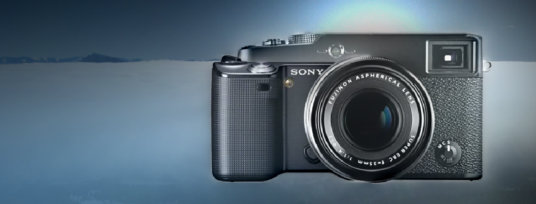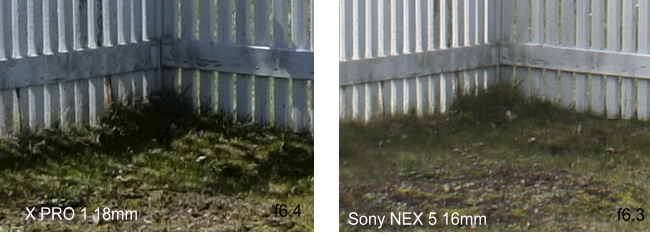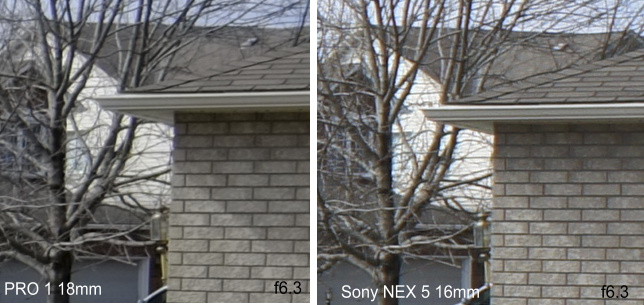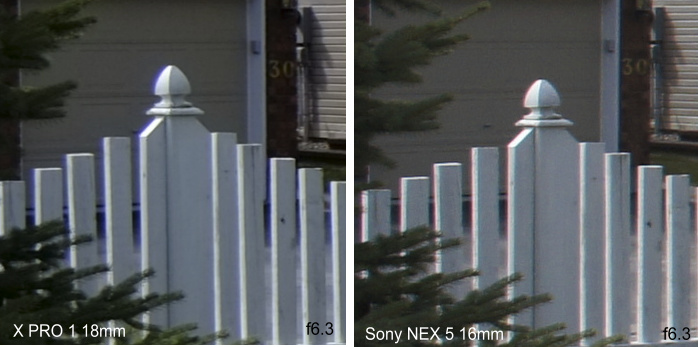Fuji X PRO 1 18mm vs Sony NEX 5 16mm (part 2)
In the previous installment I tried to compare the Fuji X100 lens to the Fuji x pro 1 18mm lens.

While I am sure some people may feel this comparison is not fair for whatever many reasons (where the price difference could be the biggest one), but I disagree. In fact the general purpose-oriented idea of both cameras is very similar, both are mirrorless, interchangeable lens cameras that are neither big, not truly pocketable (although the NEX with its 16mm is far closer to be one), neither one is DSLR and while there is certainly a very significant price difference (xpro1 with 18mm is nearly 4x more expensive than NEX 5 with 16mm) we know that price and quality is never a linear function.
Instead of reusing the previous tests, I reshoot this test again with the xpro1 to be certain of maximum fairness due to changing light conditions. ISO is set to native ISO and both lenses were set to f6.4
Center area
All lenses are at their best in the very center and so we actually see significantly more of the sensor and camera influence than the lenses themselves. So instead of comparing the lenses which would be impossible from the center, I am using this as a "base" shot and see how much the quality and resolution changes towards edges in other shots. Both crop images are 1:1

My View: While I am not going to compare the central shot between the two cameras, an obvious comment: we see a lot of "fuji colors" here.
Edges, Low contrast "gray" image
This part of my test scene always make any lens and
camera work really hard for their (or rather my)
money and it shows any deficiency in resolving
details and contrast. There is very little color for
the cameras to wave their magic wands in front of my
eyes, so I can freely focus on the details, contrast
and the sharpness without being distracted. (oops
the left image should say f6.4 not f6.3)

My view: Both lenses starts to show axial chromatic aberration problems in almost the same amount only the xpro1 goes to blue and the Sony goes to red (different sensor or lens architecture?). 16mm Sony lens keeps sharpness pretty much with its center, while the 18mm fuji is getting softer. If you look closely in the branches, you may see that Sony also resolves more of fine details, there is more suggestion of tiny branches. Because of the little saturation of this scene fuji can't show off its color engine and so both of the images are close enough in presence.
Extreme Edge Area and axial chromatic aberration.
Next is the extreme edge in regard of chromatic
aberration with contrast subject and reflection to
get as much CA distortion as possible. (oops the left image
should say f6.4 not f6.3)

My view: Again I think the axial chromatic aberration is on par, just the opposite hue. In details both camera/lens systems are close enough. It is very close call but sony system is perhaps giving us bit of more resolution (look at needles of the tree).
My final opinion of this (very subjective) test
With the center image we can largely ignore the lens influence and so it shows what I already knew and didn't need to test, the sensor and processing of Fuji has the upper hand and this is obviously where out money goes. However as we get closer to the edge of the frame, this advantage diminishes where sony lens still tries to keep its center sharpness, the fuji loses it and as a system (lens/CCD) ends up just perhaps a little bit softer below the sony system.
That is pretty interesting as I usually hear rather disappointing comments about the sony 16mm prime, but I must say the gripe must be more with the camera image processing, or with the operator himself, not with the lens, the lens seems to be pretty well equalized for such a wide angle and reasonably sharp edge-to edge. Also pricewise it is half of the fuji 18mm price. I would not hesitate to own the Sony 16mm but perhaps on a more modern body like NEX 5N or NEX 7.
Both lenses have equal amount of axial chromatic aberration (and very little of lateral CA) and it starts affect the image about the same distance from the center, just different hue.
As for the 18mm on fuji, the xpro1 sensor and processing makes up for the lens edge-to-edge deficiency but if I compare purely lens vs lens, the 16mm Sony is in fact a surprisingly good performer for half of the fuji 18mm price.
Previous: xpro1 18mm vs X100
Coming soon: Xpro1 18mm vs Panasonic GF1 20mm (Surprising result!) and the tests with the highly appreciated 35mm on fuji vs other similar lenses on sony A55 and 5DMK2
New: Photo Blend
DP HDR 5
Special Offer
Click Buy button and add the DPHDR.




